Staking
Staking is the process of temporarily locking tez on the Tezos platform. Staking contributes to the economic security of the network. As an incentive for staking, stakers receive rewards proportional to how much they stake.
Staked tez stays in the staker's account, but the staker cannot transfer (or spend) that tez. Stakers can unstake the tez at any time, which makes the tez spendable again after a delay; see Staking periods and delays.
Two main groups stake on Tezos:
-
Bakers, the creators and validators of new blocks in Tezos, must have a baking power of at least 6,000 tez to receive the right to "bake" blocks, validate other bakers' blocks, and receive rewards for baking and validating. A baker's baking power includes the tez that the baker stakes and the tez that users stake with them. The staked tez ensures that they bake correctly, because part of their baking power is taken ("slashed") if they misbehave. In this way, staking provides an economic incentive to keep Tezos running properly. For more information about staking for baking purposes, see Bakers.
-
Any Tezos user can stake tez with a baker and earn rewards. In exchange for staking tez with a baker, users automatically receive a portion of the baker's rewards in proportion to how much they stake. Users can stake any amount of tez, but there is a limit to how much staked tez a given baker can accept, and bakers must opt in to allow users to stake with them.
The amount of tez that you receive for staking tez depends on how much you stake, but also on how well your baker performs. If your baker misses opportunities to bake blocks, they don't get rewards for those blocks, which decreases rewards for you, too. You can look up an estimated rate of return on block explorers.
Staking with a baker
The process of staking with a baker (without being a baker yourself) has these main steps:
-
You select a baker as a delegate for your account. As described in Delegating to a baker, delegating tez to a baker puts that tez toward the baker's voting and baking power. Delegating incurs no risk to you; you retain full control of the tez, you can spend it at any time, and you are not punished if the baker misbehaves.
-
You choose an amount of tez and stake that tez with the baker. Staking the tez locks them temporarily, but the tez stay in your account.
You can stake any amount of your tez, up to the limit of what the baker can accept. However, you should always retain at least a small amount of unstaked tez to pay for transaction fees.
If the baker misbehaves, their punishment also affects tez staked with them, so it's important to choose a responsible baker.
-
You can leave your tez staked for as long as you want. During this time the rewards are added to your account automatically.
The process of unstaking has these main steps:
-
When you want to stop staking, you decrease the amount that you have staked or unstake all of your staked tez.
-
After a delay of up to 4 days (3 blockchain cycles plus the time remaining in the current cycle), the tez are unfrozen, but they are not actually available in your account until the request is finalized.
-
An automated system watches for unstake requests and automatically finalizes them, so in most cases you don't need to do anything at the end of the delay; the tez are automatically made available in your account. If this system does not finalize your unstake request, you can finalize the request yourself with the Octez client
finalize unstake forcommand.
The system that automatically finalizes unstake requests is known as Finn.
At the beginning of each cycle, it checks for requests that are ready to be finalized and submits a batched operation for them.
On Mainnet, it uses the account tz1i92Eptw7UZ8JSb8j8jBFJ9Poa4TTnSQwZ.
Here are a few other things to know about delegating and staking as a Tezos user:
-
A Tezos account can have only one delegate at a time. For this reason, an account can stake with only one baker at a time. If you change bakers while staked, the staking app automatically creates an unstake request for all tez staked with your former baker. You must wait for the the unstaking delay and the unstake operation finalization; only then will you be able to stake with the new baker.
-
Although bakers have no control over any tez that is staked with them, staked and delegated tez counts toward their voting rights when it's time to vote on upgrades to Tezos, as described in Governance and self-amendment.
-
Before user staking was introduced to Tezos, only bakers could stake. Users delegated their tez to bakers and bakers could choose to reward users for doing so. Currently, you can still choose to delegate without staking, but the primary way users earn rewards now is to both delegate and stake. Delegating without staking incurs less risks but brings only a fraction of the rewards.
Your staked tez is subject to the same penalties as the baker's staked tez — they are indeed at stake as a part of the baker's security deposit. In the rare event that your baker is punished ("slashed") for misbehaving, your tez is also slashed. The amount of your tez that is slashed is in proportion to your stake's weight towards the baker's total baking power.
How to stake
The easiest way to stake is to use the staking web application at https://stake.tezos.com, which walks you through the process. If you don't want to use this application, some wallets (such as Umami and Temple) have built-in staking functionality that you can use instead. Similarly, some cryptocurrency exchanges allow you to stake directly from their interfaces. However, you should evaluate these staking functions carefully because they may have different conditions and rewards than staking directly through the Tezos system and https://stake.tezos.com. For testing purposes, there is a Ghostnet staking site at https://stake-ghostnet.tezos.com.
Make sure that you are staking at the right URL (https://stake.tezos.com). As with all decentralized applications, do not trust unknown sites asking you to sign transactions and never give your private seed phrase to anyone.
-
Make sure you have tez tokens in a supported Tezos wallet. For a list of popular wallets, see Wallets.
-
Go to https://stake.tezos.com in a web browser.
-
Click Connect, select your wallet, and accept the connection in your wallet app. The staking app shows your account balance and how much you have staked.
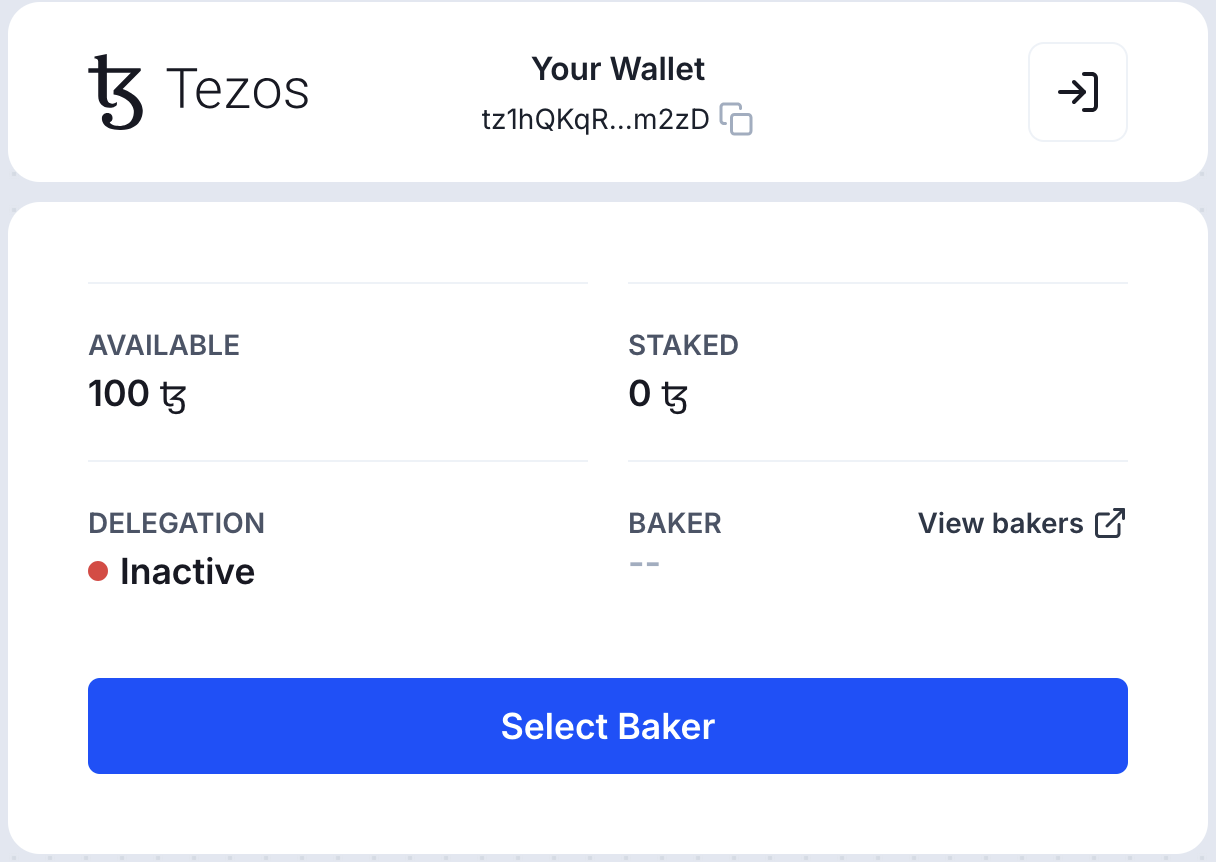
-
Click Start Earning.
-
In the popup window, click the option to delegate or stake; in most cases, click Stake.
-
Click Select Baker.
The window shows bakers and information about their fees and free space for staking:
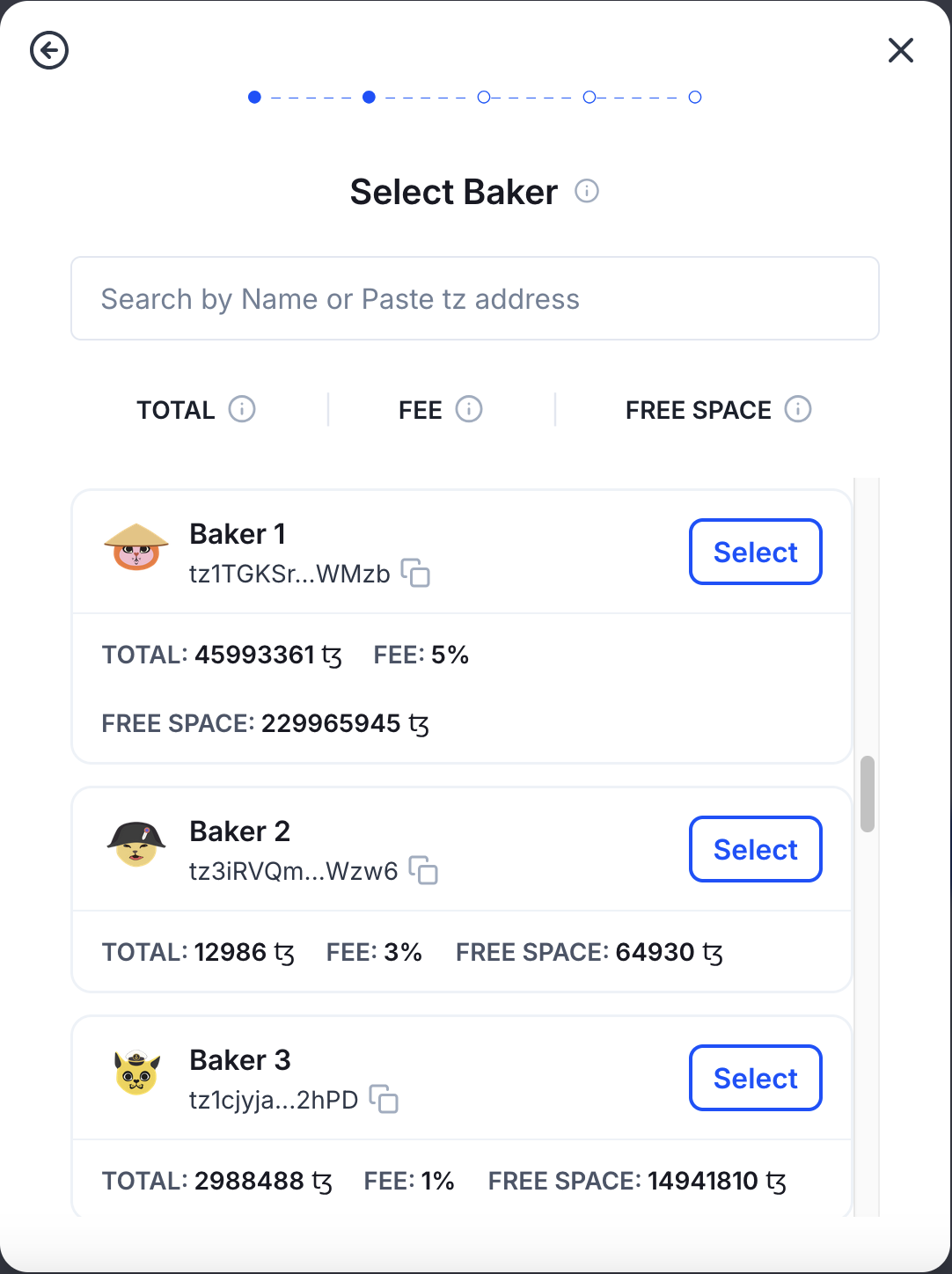
For more information about bakers, you can look them up in a block explorer by their addresses. For example, the block explorer tzkt.io has information on bakers at https://tzkt.io/bakers and tzstats.com has information at https://tzstats.com/bakers. Evaluate bakers by comparing information about them, including:
- The fees they charge (commission) on rewards
- Their capacity for additional staked funds (free space)
- How reliable they are as a baker (how often they bake blocks when they have the opportunity)
- Whether they have been penalized (slashed) in the past
For example, the bakers in this picture all have free space for staking:

-
Choose a baker and click Select next to them.
The application prompts you to delegate your account to that baker, as in this screenshot:
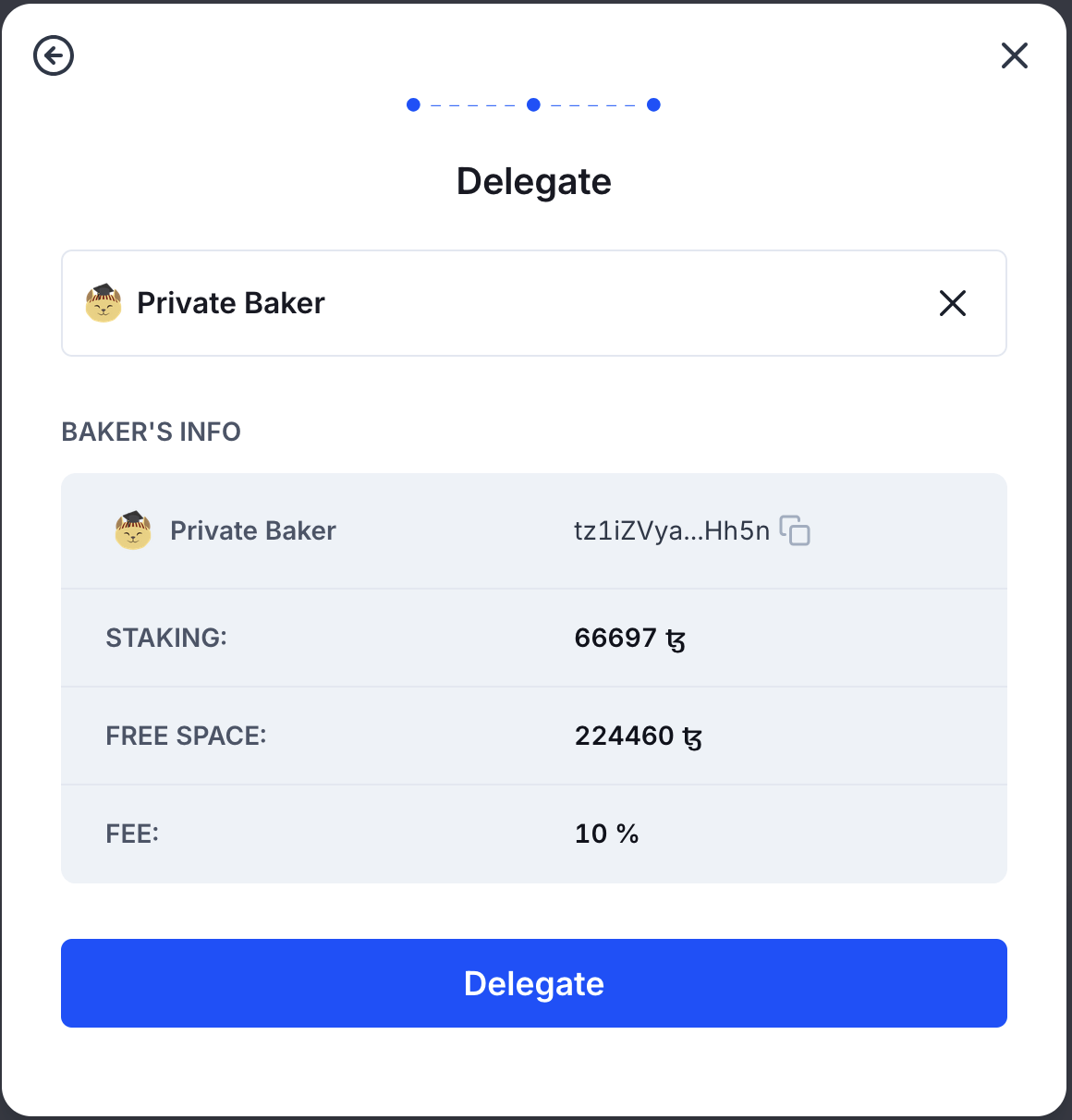
-
Click Continue and approve the operation in your wallet to delegate to that baker. It may take a few seconds for the operation to be final. When the transaction is final, the Stake Amount window opens.
-
In the Stake Amount window, specify the amount to stake.
noteDon't stake all of the tez in the account; you need some liquid tez to pay transaction fees. For this transaction, the application deducts the transaction fee from the amount that you stake. However, you will need liquid, unstaked tez later to unstake the tez. Leaving 1 tez in your liquid balance is enough.
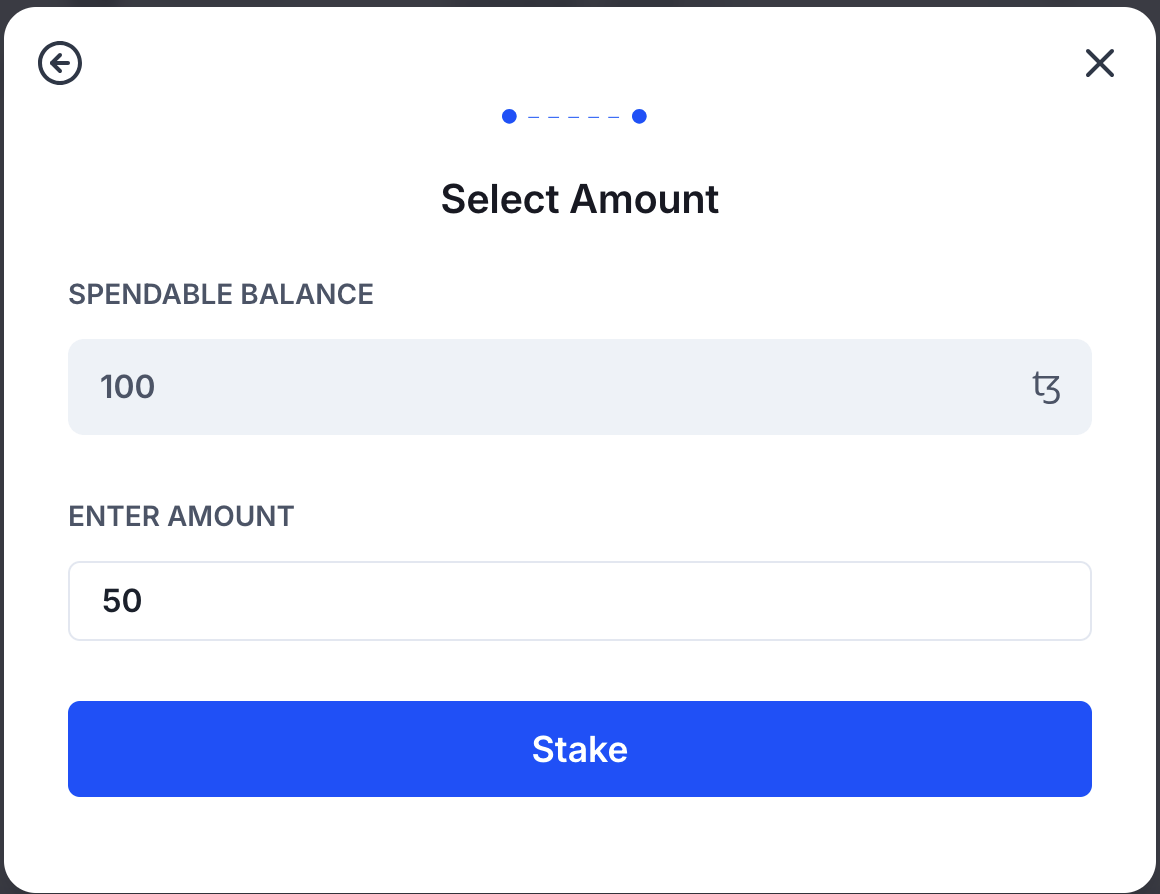
-
Click Stake, confirm the terms of use for the staking application, click Stake again, and confirm the transaction in your wallet. This operation may also take a few seconds.
When the staking operation is complete, a confirmation page shows how much you have staked and provides a link to tzkt.io that you can use to see information about your account. The web application also shows the current status of your account, as in this screenshot:
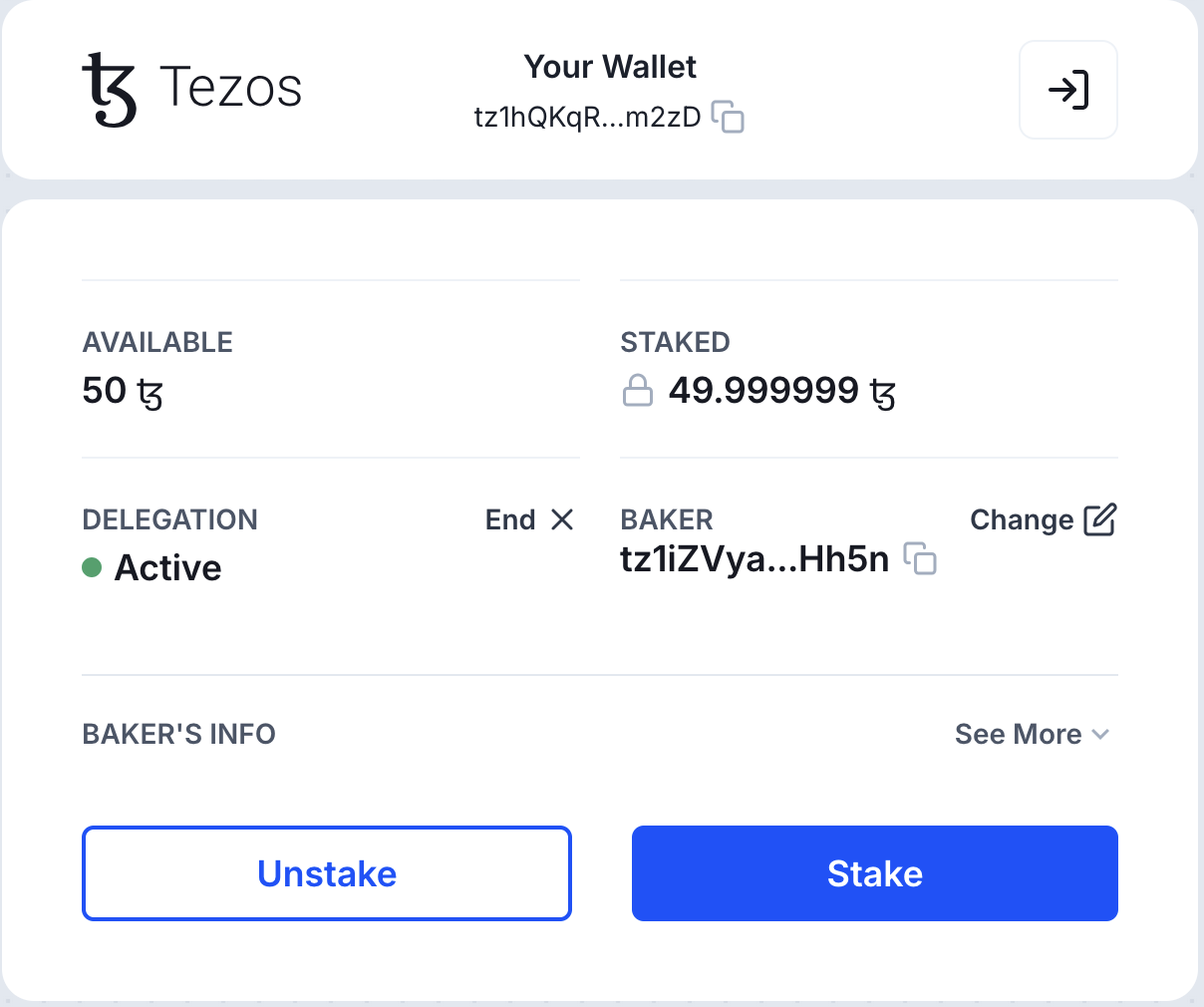
How to unstake
You can unstake any amount of staked tez at any time, but you must wait for the 4-day delay for the unstaked funds to be made available in your account.
Staked funds are part of the security deposit of the chosen baker, so they must remain frozen while they remain at stake. Tezos calculates how much is staked with a baker at the end of blockchain cycles, and it requires tez staked at the end of the current cycle to be frozen for the next three cycles. For this reason, you must wait three cycles to finalize an unstake request, which can take up to 4 days (including three cycles plus the time remaining in the current cycle).
For more information, see Staking periods and delays.
-
Go to https://stake.tezos.com in a web browser and connect your wallet.
-
Click Unstake, read the notice about the delay, and click I Understand.
-
Select the amount to unstake, up to the total amount that is currently staked, as in this screenshot:

-
Click Unstake and confirm the transaction in your wallet. When the unstaking operation is complete, a confirmation page shows how much you have unstaked and provides a link to tzkt.io that you can use to see information about your account.
Then, the application shows the pending unstake request and the cycle in which the request can be finalized, as in this screenshot:
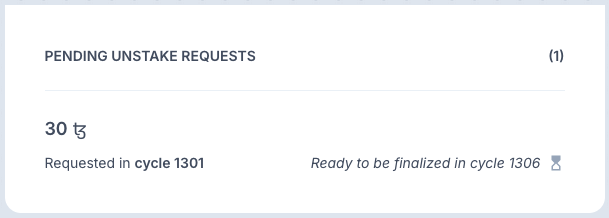
-
Wait for the unstaking delay and for your tez to become available in your account. You can check your unstaked balance with many tools including block explorers.
Now the application shows your liquid balance and any tez that remain staked.
Viewing your rewards
The Tezos protocol distributes staking rewards automatically, without requiring any manual action. To see them, look up your account on a block explorer such as TzKT.
If your baker pays delegation rewards (this concerns the amount of liquid, non-staked tez in your account), the baker distributes those rewards to you using transactions.
Staking periods and delays
The following diagram shows the reason for the unstaking delay. The diagram shows cycles as a timeline and assumes that the user has already staked tez with a baker at the start of the timeline.
The system calculates rights for bakers two cycles ahead, so at the end of cycle 1, the system calculates rights for a baker in cycle 4 based on the amount staked with that baker as of the end of cycle 1. The example user in the diagram submits an unstake request in the middle of cycle 2. When cycle 2 ends, the system calculates rights for bakers in cycle 5, so the baker will have reduced staking rights in cycle 5 depending on how much the user requested to unstake. During this time, the funds in the unstake request are no longer considered staked to tbe baker, but they are still delegated to the baker, so they still affect the baker's baking rights.
The diagram also shows why users must wait to unfreeze their staked tez. Because the rights in cycles 3 and 4 were computed before the unstake request, the funds being unstaked must still guarantee the honest behavior of the baker during that period. The diagram shows a baker misbehaving in cycle 4. Other bakers have the remainder of cycle 4 and all of cycle 5 to denounce the misbehaving baker, which results in that baker being slashed. Therefore, funds staked with that baker stay frozen until the end of cycle 5 in case they need to be penalized. Then, Finn (the unstake bot) or any user can finalize the unstake request.
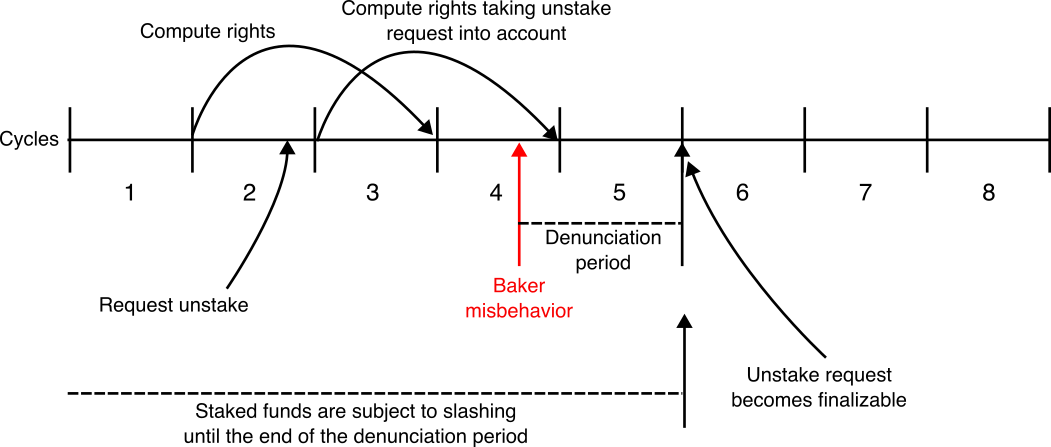
More information
For technical information about delegating, staking, and rewards, see these pages in the Octez documentation: